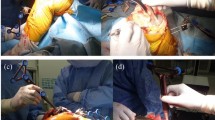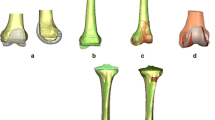Abstract
Purpose
There is conflicting evidence whether custom instrumentation for total knee arthroplasty (TKA) improves component position compared to standard instrumentation. Studies have relied on long-limb radiographs limited to two-dimensional (2D) analysis and subjected to rotational inaccuracy. We used postoperative computed tomography (CT) to evaluate preoperative three-dimensional templating and CI to facilitate accurate and efficient implantation of TKA femoral and tibial components.
Methods
We prospectively evaluated a single-surgeon cohort of 78 TKA patients (51 custom, 27 standard) with postoperative CT scans using 3D reconstruction and contour-matching technology to preoperative imaging. Component alignment was measured in coronal, sagittal and axial planes.
Results
Preoperative templating for custom instrumentation was 87 and 79 % accurate for femoral and tibial component size. All custom components were within 1 size except for the tibial component in one patient (2 sizes). Tourniquet time was 5 min longer for custom (30 min) than standard (25 min). In no case was custom instrumentation aborted in favour of standard instrumentation nor was original alignment of custom instrumentation required to be adjusted intraoperatively. There were more outliers greater than 2° from intended alignment with standard instrumentation than custom for both components in all three planes. Custom instrumentation was more accurate in component position for tibial coronal alignment (custom: 1.5° ± 1.2°; standard: 3° ± 1.9°; p = 0.0001) and both tibial (custom: 1.4° ± 1.1°; standard: 16.9° ± 6.8°; p < 0.0001) and femoral (custom: 1.2° ± 0.9°; standard: 3.1° ± 2.1°; p < 0.0001) rotational alignment, and was similar to standard instrumentation in other measurements.
Conclusions
When evaluated with CT, custom instrumentation performs similar or better to standard instrumentation in component alignment and accurately templates component size. Tourniquet time was mildly increased for custom compared to standard.
Level of evidence
Level I, prospective diagnostic.




Similar content being viewed by others
References
Aglietti P, Sensi L, Cuorno P, Ciardullo A (2008) Rotational position of femoral and tibial components in TKA using the femoral transepicondylar axis. Clin Orthop Relat Res 466:2751–2755
Bellemans J (2011) Neutral mechanical alignment: a requirement for successful TKA (Opposes). Orthopedics 34:e507–e509
Berger RA, Crossett LS (1998) Determining rotation of the femoral and tibial components in total knee arthroplasty: a computer tomography technique. Oper Tech Orthop 8:128–133
Chauhan S, Clark G, Lloyd S, Scott R, Breidahl W, Sikorski J (2004) Computer-assisted total knee replacement. A controlled cadaver study using a multi-parameter quantitative CT assessment of alignment (the Perth CT protocol). J Bone Joint Surg Br 86:818–823
Chung BJ, Kang YG, Chang CB, Kim SJ, Kim TK (2009) Differences between sagittal femoral mechanical and distal reference axes should be considered in navigated TKA. Clin Orthop Relat Res 467:2403–2413
Cobb JP, Dixon H, Dandachli W, Iranpour F (2008) The anatomical tibial axis: reliable rotational orientation in knee replacement. J Bone Joint Surg Br 90:1032–1038
Conteduca F, Iorio R, Mazza D, Caperna L, Bolle G, Argento G, Ferretti A (2012) Are MRI-based, patient matched cutting jigs as accurate as the tibial guides? Int Orthop 36:1589–1593
Conteduca F, Iorio R, Mazza D, Caperna L, Bolle G, Argento G, Ferretti A (2012) Evaluation of the accuracy of a patient-specific instrumentation by navigation. Knee Surg Sports Traumatol Athrosc. doi:10.1007/s00167-012-2098-z
Dennis DA (2008) Measured resection: an outdated technique in total knee arthroplasty. Orthopedics 31(940):943–944
Engh GA, Peterson TL (1990) Comparative experience with intramedullary and extramedullary alignment in total knee arthroplasty. J Arthroplasty 5:1–8
Gujarathi N, Putti AB, Abboud RJ, MacLean JG, Espley AJ, Kellett CF (2009) Risk of periprosthetic fracture after anterior femoral notching. Acta Orthop 80:553–556
Henckel J, Richards R, Lozhkin K, Harris S, Rodriguez y Baena F, Barrett A, Cobb J (2006) Very low-dose computed tomography for planning and outcome measurement in knee replacement. J Bone Joint Surg Br 88:1513–1518
Howell SM, Chen J, Hull ML (2012) Variability of the location of the tibial tubercle affects the rotational alignment of the tibial component in kinematically aligned total knee arthroplasty. Knee Surg Sports Traumatol Arthrosc. doi:10.1007/s00167-012-1987-5
Jerosch J, Peuker E, Phillipps B, Filler T (2002) Interindividual reproducibility in perioperative rotational alignment of femoral components in knee prosthetic surgery using the transepicondylar axis. Knee Surg Sports Traumatol Arthrosc 10:194–197
Kannan A, Hawdon G, McMahon SJ (2012) Effect of flexion and rotation on measures of coronal alignment after TKA. J Knee Surg 25:407–410
Konigsberg B, Hess R, Hartman C, Smith L, Garvin KL (2013) Inter- and intra-observer reliability of two-dimensional CT scan for total knee arthroplasty component malrotation. Clin Orthop Relat Res. doi:10.1007/s11999-013-3111-7
Kurtz S, Ong K, Lau E, Mowat F, Halpern M (2007) Projections of primary and revision hip and knee arthroplasty in the United States from 2005 to 2030. J Bone Joint Surg Am 89:780–785
Lesh ML, Schneider DJ, Deol G, Davis B, Jacobs CR, Pellegrini VDJ (2000) The consequences of anterior femoral notching in total knee arthroplasty: a biomechanical study. J Bone Joint Surg 82-A:1096–1101
Lombardi AVJ, Berend KR, Ng VY (2011) Neutral mechanical alignment: a requirement for successful TKA: affirms. Orthopedics 34:e504–e506
Lonner JH, Laird MT, Stuchin SA (1996) Effect of rotation and knee flexion on radiographic alignment in total knee arthroplasties. Clin Orthop Relat Res 331:102–106
Lutzner J, Krummenauer F, Gunther KP, Kirschner S (2010) Rotational alignment of the tibial component in total knee arthroplasty is better at the medial third of the tibial tuberosity than at the medial border. BMC Musculoskel Disord 11:57
Mahoney O, Kinsey T (2010) Overhang of the femoral components in total knee arthroplasty: risk factors and clinical consequences. J Bone Joint Surg Am 92:1115–1121
Mason JB, Fehring TK, Estok R, Banel D, Fahrbach K (2007) Meta-analysis of alignment outcomes in computer-assisted total knee arthroplasty surgery. J Arthroplasty 22:1097–1106
Matziolis G, Adam J, Perka C (2010) Varus malalignment has no influence on clinical outcome in midterm follow-up after total knee replacement. Arch Orthop Trauma Surg 130:1487–1491
Matziolis G, Krocker D, Weiss U, Tohtz S, Perka C (2007) A prospective, randomized study of computer-assisted and conventional total knee arthroplasty. Three-dimensional evaluation of implant alignment and rotation. J Bone Joint Surg Am 89:236–243
Moreland JR, Bassett LW, Hanker GJ (1987) Radiographic analysis of the axial alignment of the lower extremity. J Bone Joint Surg Am 69:745–749
Ng VY, DeClaire JH, Berend KR, Gulick BC, Lombardi AVJ (2012) Improved accuracy of alignment with patient specific positioning guides compared with manual instrumentation in total knee arthroplasty. Clin Orthop Relat Res 470:99–107
Ng VY, McShane MA (2012) MRI-based pin guide patient specific instruments. In: Thienpont E (ed) Improving accuracy in knee arthroplasty. Jaypee Publishers, New Delhi, pp 233–252
Nunley RM, Ellison BS, Ruh EL, Williams BM, Foreman K, Ford AD, Barrack RL (2012) Are patient-specific cutting blocks cost-effective for total knee arthroplasty? Clin Orthop Relat Res 470:889–894
Nunley RM, Ellison BS, Zhu J, Ruh EL, Howell SM, Barrack RL (2012) Do patient-specific guides improve coronal alignment in total knee arthroplasty? Clin Orthop Relat Res 470:895–902
Olcott CW, Scott RD (2000) A comparison of 4 intraoperative methods to determine femoral component rotation during total knee arthroplasty. J Arthroplasty 15:22–26
Parratte S, Pagnano MW, Trousdale RT, Berry DJ (2010) Effect of postoperative mechanical axis alignment on the 15-year survival of modern, cemented total knee replacements. J Bone Joint Surg Am 92:2143–2149
Petersen TL, Engh GA (1988) Radiographic assessment of knee alignment after total knee arthroplasty. J Arthroplasty 3:67–72
Radtke K, Becher C, Noll Y, Ostermeier S (2010) Effect of limb rotation on radiographic alignment in total knee arthroplasties. Arch Orthop Trauma Surg 130:451–457
Ritter M, Thong A, Keating E, Faris P, Meding J, Berend M, Pierson J, Davis K (2005) The effect of femoral notching during total knee arthroplasty on the prevalence of postoperative femoral fractures and on clinical outcome. J Bone Joint Surg Am 87:2411–2414
Seo JG, Kim BK, Moon YW, Kim JH, Yoon BH, Ahn TK, Lee DH (2009) Bony landmarks for determining the mechanical axis of the femur in the sagittal plane during total knee arthroplasty. Clinics Orthop Surg 1:128–131
Siston RA, Goodman SB, Patel JJ, Delp SL, Giori NJ (2006) The high variability of tibial rotational alignment in total knee arthroplasty. Clin Orthop Relat Res 452:65–69
Stoeckl B, Nogler M, Krismer M, Belmel C, de la Barrera JL, Kessler O (2006) Reliability of the transepicondylar axis as an anatomical landmark in total knee arthroplasty. J Arthroplasty 21:878–882
Stronach B, Pelt C, Erickson J, Peters CL (2013) Patient-specific instrumentation in TKA required frequent surgeon directed intraoperative changes. Clin Orthop Relat Res 471:169–174
Stronach B, Pelt C, Erickson J, Peters CL (2012) Patient-specific instrumentation in total knee arthroplasty provides no improvement in component alignment. J Knee Surg 25:213–219
Tang WM, Chiu KY, Kwan MF, Ng TP, Yau WP (2005) Sagittal bowing of the distal femur in Chinese patients who require total knee arthroplasty. J Orthop Res 23:41–45
Walensky NA (1965) A study of anterior femoral curvature in man. Anat Rec 151:559–570
Yehyawi TM, Callaghan JJ, Pedersen DR, O’Rourke MR, Liu SS (2007) Variances in sagittal femoral shaft bowing in patients undergoing TKA. Clin Orthop Relat Res 464:99–104
Zalzal P, Backstein D, Gross AE, Papini M (2006) Notching of the anterior femoral cortex during total knee arthroplasty. J Arthroplasty 21:737–743
Acknowledgments
Study funding provided by Zimmer Inc. (Warsaw, IN, USA).
Conflict of interest
None.
Author information
Authors and Affiliations
Corresponding author
Rights and permissions
About this article
Cite this article
Ng, V.Y., Arnott, L., Li, J. et al. Comparison of custom to standard TKA instrumentation with computed tomography. Knee Surg Sports Traumatol Arthrosc 22, 1833–1842 (2014). https://doi.org/10.1007/s00167-013-2632-7
Received:
Accepted:
Published:
Issue Date:
DOI: https://doi.org/10.1007/s00167-013-2632-7




